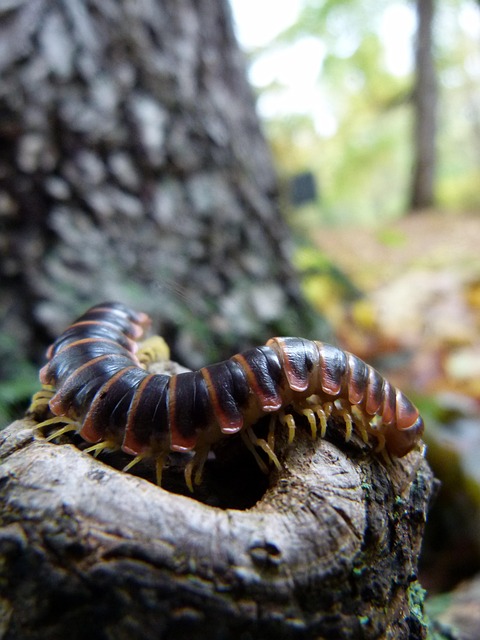Centipedes, preferring moist dark spaces, reach 15 cm in some species and primarily feed on small insects at night. Professional centipede extermination requires understanding their behavior and hiding spots for effective deployment of modern detection and removal technologies like heat treatments and insect growth regulators (IGRs). Advanced digital tools like high-res cameras, thermal imaging, and pheromone sensors enhance accuracy and reduce chemical use, offering safer and more sustainable centipede control methods.
In the realm of pest control, centipedes pose a unique challenge due to their elusive nature and intricate habitats. Understanding these creatures’ behavior is the first step towards effective professional centipede extermination. This article delves into the world of advanced technologies designed to detect and remove centipedes, offering modern solutions for those seeking expert assistance. From traditional methods to cutting-edge tools, we explore strategies that revolutionize pest management, ensuring a centipede-free environment.
Understanding Centipedes: Behavior and Habitats
Centipedes are a type of arachnid known for their elongated bodies and numerous legs, with some species reaching lengths of over 15 cm. They prefer moist, dark environments and are commonly found in areas such as basements, crawl spaces, and bathrooms. These creatures are not aggressive but can deliver a painful bite if provoked or handled. Understanding centipede behavior is crucial for effective professional centipede extermination.
Centipedes are solitary creatures and typically hunt at night, feeding on small insects, arachnids, and other invertebrates. They use their strong jaws to inject venom into their prey, paralyzing it before consuming it. Their preference for damp environments makes them particularly prevalent in regions with high humidity. Identifying their hiding spots and understanding their behavior allows professionals to employ advanced technologies for centipede detection and removal, ensuring effective and efficient control of these pesky invaders.
Traditional Extermination Methods
Centipedes, with their many legs and often intimidating appearance, have long been a nuisance for homeowners. Traditional methods of extermination involve the use of chemical pesticides, which can be effective but come with their own set of drawbacks. These chemicals may pose health risks to both humans and pets, and they can also have negative impacts on the environment if not used properly. Additionally, many centipede species are becoming resistant to conventional pesticides, rendering them less effective over time.
Professional centipede extermination services now offer more advanced and targeted solutions. Modern techniques include heat treatments, which use precisely controlled temperatures to kill centipedes without harming other pests or structures. Another innovative approach is the use of specialized insect growth regulators (IGRs) that disrupt the centipedes’ ability to molt, ultimately leading to their demise. These methods not only provide more effective centipede control but also contribute to a safer and more sustainable environment.
Advanced Technologies for Detection
In today’s digital era, advanced technologies have revolutionized the way we approach centipede detection and removal, elevating professional centipede extermination to new heights. Traditional methods are being supplemented by innovative tools that enhance accuracy and efficiency. For instance, high-resolution cameras and thermal imaging devices enable exterminators to spot even the most elusive centipedes in hard-to-reach corners, ensuring a thorough inspection. Additionally, specialized sensors can detect pheromones and other chemical trails left by these creatures, providing an early warning system for their presence.
These cutting-edge technologies offer more than just improved detection; they also aid in targeted treatment. With real-time data on centipede activity and patterns, professionals can deploy effective solutions precisely where needed, minimizing the use of chemicals and reducing environmental impact. As a result, advanced technologies not only facilitate efficient centipede removal but also contribute to a safer and more sustainable approach to pest control, catering to those seeking professional centipede extermination services.
Effective Removal Strategies Using Modern Tools
In the realm of professional centipede extermination, modern tools have revolutionized the way these pesky intruders are handled. Effective removal strategies now incorporate advanced technologies that offer precise and efficient solutions. One such innovation is the use of high-tech sensors and cameras that can detect centipedes in hard-to-reach areas, providing a comprehensive survey of infested spaces. This early detection allows for targeted treatments, minimizing the use of harsh chemicals and ensuring a safer environment.
Additionally, modern tools facilitate the application of specialized pesticides and baits designed specifically for centipede control. These products are often less toxic and more eco-friendly, catering to the growing demand for sustainable pest management practices. Professional exterminators can now harness the power of these modern tools, offering tailored solutions that eliminate centipedes effectively while maintaining a balance in the overall ecosystem.
In conclusion, the effective management of centipede infestations requires a combination of understanding their unique behaviors and utilizing advanced technologies for both detection and removal. Traditional methods, while useful, often fall short in addressing larger-scale or persistent centipede problems. Modern tools, such as innovative sensors and targeted treatments, offer more precise and long-lasting solutions. By adopting these advanced techniques, professional centipede extermination services can provide homeowners with lasting relief from these unwelcome intruders.
